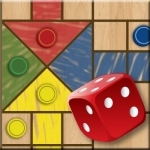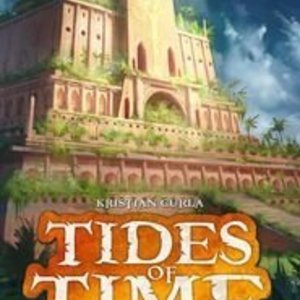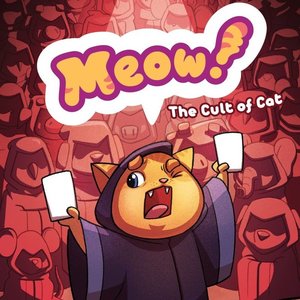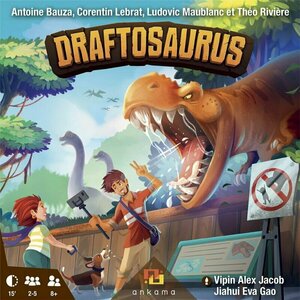Purple Phoenix Games (2266 KP) rated Cthulhu Realms in Tabletop Games
Jun 12, 2019
In Cthulhu Realms, a deck-building game, you are a Cthulhu cultist that is trying to drive your rivals literally insane. By gathering followers, collecting artifacts, and discovering new locations, you will gain enough power to influence the sanity of those who would oppose you! On your turn, you will play cards from your hand to Conjure (acquire new cards from the communal pool), Draw/Discard cards, Gain/Lose Sanity, or Abjure (permanently discard cards from the game). The game ends when a player is reduced to zero sanity – and the player who has retained their sanity is the winner!
I love deck-building games. I really do. I think it’s a neat mechanic that allows you to customize your strategy with every play. So I enjoy playing Cthulhu Realms because of that element. And that’s kind of where my enjoyment ends with this game. Don’t get me wrong – it’s a decent game. I just have a couple of issues with the actual cards and abilities. The cards themselves are very reliant on iconography to communicate powers/abilities. Props to the player boards for having a quick reference for the basic actions, but I still always keep the rule sheet on hand for the in-depth explanation as I play. And even then, the rule sheet still has a bit of ambiguity on how some of the powers work. I wish they’d provided a couple of examples because sometimes I still get confused by certain combinations of icons. Just a little more detail in the rule sheet could alleviate some of the ambiguity of the icon abilities.
For card abilities, each individual card can have anywhere from 1-3 special abilities. The tricky thing is that the abilities do not all have to be used at the same time. So I could use 1 ability from a card, use an ability from a different card, and then come back to my first card and use another of it’s printed abilities. And with a hand of 5 cards every turn (not counting additional cards you may draw…), it can be hard to keep track of which abilities you’ve already used that turn. On top of that, many of the abilities have prerequisites – you can’t use that specific ability unless you’ve already played/have in play the requisite card. Some abilities only have 1 prerequisite, but some have 2, which just adds another layer of bookkeeping to your turns. Not only are you trying to remember which card abilities you’ve already used, but you’re also trying to keep track of your cards/actions that turn that could unlock other card abilities. The rule sheet suggests sliding a card to one side of your play area once you’ve used one of its powers. But again, if it has more than 1 ability on it, you’ve got to remember which ones you’ve used/haven’t used yet, regardless of where they are in your play area. This is a competitive game overall, but with all of these elements to track on your turns, it saps the tension from the game and makes it feel a little more luck-based than strategic.
To alleviate some of my grievances, I think the game could just have more cards with fewer abilities on each. That would make it much easier to execute all of your turns. And eliminate some of the ability prerequisites – having them on most of the abilities just adds another element for you to keep track of, and it feels a little unnecessary. If the turns were a little more clear and concise, I would like this game a lot more. It’s not bad, it just gets bogged down a little bit with too much action on your turns. That’s why Purple Phoenix Games gives Cthulhu Realms a 6/12.
https://purplephoenixgames.wordpress.com/2019/03/22/cthulhu-realms-review/
Purple Phoenix Games (2266 KP) rated Tides of Time in Tabletop Games
Oct 17, 2019
Tides of Time is a card drafting and set collection mini civilization building game that spans three ages (rounds). The player with the most amount of VPs at the end of the game is the winner. The VPs are scored at the end of each round and then added to arrive at the final score. You earn VPs throughout the game by having cards in your civ that feed off each other in amazing combo play.
To setup, shuffle the big civ element cards and deal each player a hand of five. Place the others nearby to draw from during the subsequent rounds. Place the “Relic of the Past” tokens nearby as well. You are ready to play.
On your turn you will draft one card from your hand, then pass to your opponent. When you select a card, play it to your tableau in front of you. Continue this simple draft until you have your Round 1 civilization cards ready to score. Each card will belong to one of five suits, with three card being unsuited, and each card having some sort of scoring ability or special ability to affect the cards in play. Example: having a majority in crown suit cards will score you 7 VP (the top leftmost card in the play pic below). Obviously if you have played this card early in the round you want to try to amass the majority of crowns for those yummy 7 VPs. This is how the card combos will generally work, with many other rules and scoring abilities to discover on your own.
At the end of Round 1 and 2 you will select one of your cards you played this round and place the “Relic of the Past” token on it. This freezes the card to your tableau to be used again in future rounds. So taking our example from before, if you chose the 7 VPs from crown majority card in Round 1, you can use it in Rounds 2 and 3 to score again should you satisfy the scoring ability. 21 VPs from one card is pretty great.
Components. This is a bunch of cards, two cardboard tokens, a score pad, and a golf pencil. The cards are great quality, and a satisfyingly large size. The tokens are good as well, and the writing supplies are good too. The artwork throughout is very very good and I enjoy studying the paintings, though they have nothing to do with game play. No complaints here at all.
I am a sucker for drafting games where you pass your hand to gain other card. Games like 7 Wonders, Among the Stars, and even Sushi Go! are really good times. When I play Tides of Time it gives me that same feeling of trying to guess your opponent’s strategy as well as fulfill your best tactics to score massive points. It is quick and light and a really great filler. There is enough variability in this one to keep me coming back for more and I definitely enjoy pulling it out giving it a run.
My only concern is that I don’t pull it off the shelf enough. It is in a weird slot of 2-player filler. When I feel like playing a great 2-player game, I will typically pull out Patchwork, 7 Wonders: Duel, or Jaipur. This really is a great game, and if you are a fan of drafting games that have you exchanging hands (as opposed to simply drafting from a face-up row or grid) then you should give this one a try. I do enjoy other games a bit more, but I am glad we have this available to us. We at Purple Phoenix Games give this one a pasted-on 8 / 12.
Purple Phoenix Games (2266 KP) rated Meow! The Cult of Cat in Tabletop Games
Jul 18, 2019
NOTE: I have never been hazed nor have I hazed another. Just wanted to get that straight.
DISCLAIMER: We were provided a review copy of this game for the purposes of this review. These are preview copy components, and I do not know if the final components will be similar or different, or if the Kickstarter campaign will alter or add anything through stretch goals. -T
As an initiate to the Cult of Cat it is your duty to pass the test and not break any rules. The winning player, therefore, is the one who can perform all of the necessary rules without breaking any. Let me explain. The game is a giant stack of cards. Upon these cards is the name of the rule, an illustration that matches the rule, and an explanation of the action to be completed. At the beginning of the game you are dealt two cards (or one card dependent on number of players in the game) and one card is dealt face-down to the middle of the table. You look at your dealt cards, study them, and pass your hand to the player on your left. So you now have seen two rules that you have passed, and you have received two rules from your neighbor on the right. I hope you remembered what you passed…
On your turn you will play a card from your hand, announce and perform its action, and then perform all the actions on your opponents’ cards that you can possibly remember to impress the brethren and hopefully not break any of their rules in the process. Once you are satisfied with your performance you point to the player on your left and ask, “Have I broken any of your rules?” If you performed one of the rules in their hand incorrectly, or omitted one of their rules, then they are required to say, “Yes.” At this point they announce the rule you have broken, add that card to the card that was dealt face-down to the table, and you add your played card to form a pile of three. Shuffle those and draw one for yourself, your opponent draws one, and the remainder stays on the table. This is the game and it continues until someone has correctly performed the actions of their opponents and not broken any rules.
Components. Again, this is a giant stack of cards. I do not know what the quality will be after the Kickstarter campaign ends, so I cannot really comment on them. My review copy cards were fine. The art on the cards is really comical and funny. I mean comical like in comic books. I like the art quite a bit, and while I am not really looking at the illustrations as I play (there is already so much I am trying to remember), when I look through the deck I chuckle at a lot of the cards.
Guys, this is a great party game. It is rules-light, doesn’t require a ton of strategy, and gets people up and moving and out of their comfort zones. It really is perfect for those times when you have reluctant players or partners to get them into the gaming mood by having them perform ridiculous but super fun actions. Winners, losers, it doesn’t matter at the end of this game. Everyone is sure to have a really great time playing. If you love Happy Salmon, I can almost guarantee that you will also love Meow! as something a little different. And we at Purple Phoenix Games love Happy Salmon! I am really looking forward to the Kickstarter campaign to see what Peter C. Hayward has up his sleeves.

Cross-Functional Inventory Research
Book
'Joe Thomas is a true renaissance academic who has integrated research, teaching, practice and...

Pool Club - 8 Ball Billiards, 9 Ball Billiard Game
Games and Entertainment
App
Snooker Pool 8 Ball is game for all snooker fans. One of the most realistic and playable pool games,...
Purple Phoenix Games (2266 KP) rated Draftosaurus in Tabletop Games
May 14, 2021
Draftosaurus is so appropriately named due to being a drafting game with a dinosaur theme. Instead of typically drafting cards, however, players are drafting adorable little dinomeeples to populate their theme park attractions. Each attraction, or pen in the game, offers different points for having different dinos in each, or the same, or just one, or exactly three, et al. The player with the most points from these pens at the end of the game is the winner!
To setup, every player receives a park board. Populate the draw bag with dinomeeples based on the number of players using the table in the rulebook. Give the wooden placement die to the youngest player and play can begin!
A game of Draftosaurus spans exactly two rounds. Each round is exactly the same: each player grabs six dinomeeples from the bag, active player rolls the die, players draft dinos, players pass the remaining dinos. Repeat these steps starting at die rolling, but the die is passed along with the dinos from the active player. This is repeated until all dinos have been drafted and placed in pens. Easy right?
The true nature of the game and the most fun part is in the placement die and placement of the dinos in the pens. When the die is rolled, this signifies specific placement rules for all players except the active player. So perhaps the die shows that dinos must be placed in the Grasslands, which are the pens on the bottom portion of the boards. Or maybe the die shows that new dinos may only be added to pens that currently have no dinos in them. Again, these rules do not apply to they that rolled the die, but rather every other player. Herein lies the scrumptious struggle: where does one place the dinos they currently possess in their hand from their neighbor? What pens will score the most points at endgame? Can a T.Rex really be appropriate in this pen? The choices can be maddening, or one can play the game with complete laissez-faire and still have a great time. After two rounds the game ends and players look upon their parks with pride as they count up their final scores.
Components. I really only know Ankama from the Krosmaster games, which though I am not really a fan of, the components are great. I believe Ankama has provided excellent components for Draftosaurus. The dinomeeples are all excellently colored and designed. The boards are good quality, though I question the “Grasslands” being brown and kinda devoid of grass. All in all, the components are great and I love handling them and playing with them.
Yes, we always include our scores at the beginning of each review. So you all already know what I’m about to say here. I love this game! I love having so many options available to me, only to have the die roll tell me I can’t do exactly what I want, so I have to alter my strategy on a dime. I love being able to see my dinos filling up the park (or swimming in the River if there are no places for them) and watching them frolic… well, okay not frolic in tight spaced pens. No wonder they all went crazy and escaped in those movies. In any case, if you or your family/friends/playdates enjoy drafting games, but want something a little different, while respecting your playtime (something that many drafting games extend) take a look at Draftosaurus. Even children can get in on the action, as there is no need to be able to read, necessarily. I haven’t yet tried it with my 3-year-old, but I think I will this weekend now. That all said, Purple Phoenix Games gives this one an enthusiastically Triassic 19 / 24. Just keep Newman and Nick Fury away from your game table.

Soccer Star 2017 Top Leagues
Games and Entertainment
App
It’s the last match of the League and you are in a drawn. It’s your turn to choose the destiny...

Classic Ludo Offline & Online
Games
App
NEW: Multiplayer Online with Facebook Friends available now. Calling all the kings of Ludo game,...

Zombie Hunter: FPS Apocalypse
Games and Entertainment
App
The new real zombie war game with incredible 3D graphics. Your goal is to survive from the undead...

Twilight Struggle
Tabletop Game
"Now the trumpet summons us again, not as a call to bear arms, though arms we need; not as a call to...
Boardgames 2playergames PoliticalGames HistoricalGames



